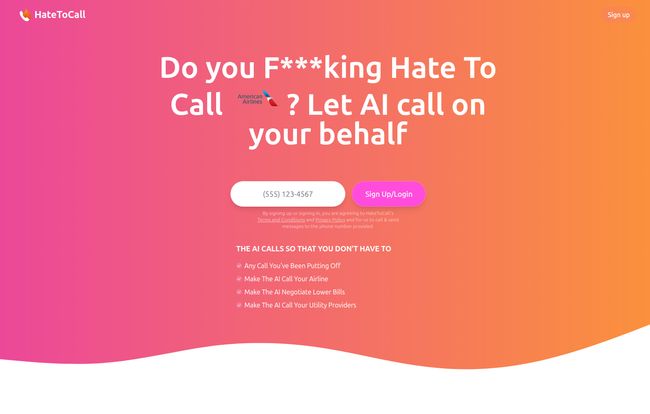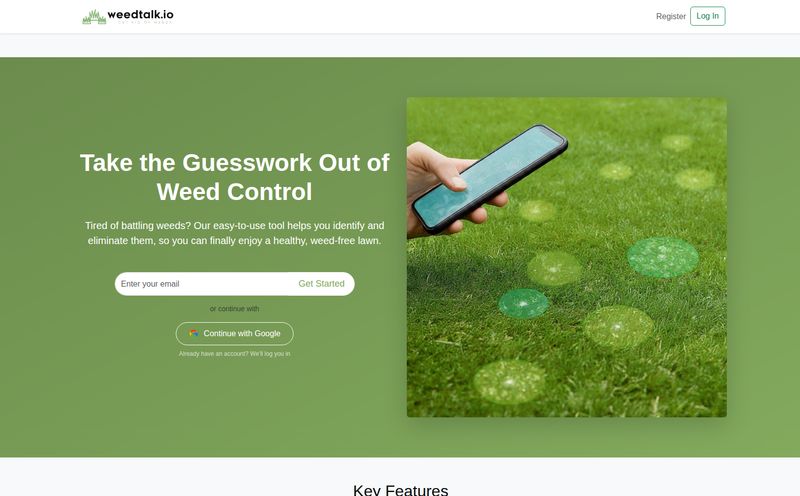There are few modern-day tortures quite like being on hold with customer service. The tinny, looping music. The cheerful-but-not-really voice that cuts in every 45 seconds to assure you that “your call is important to us.” Sure it is. I’ve lost entire afternoons of my life listening to bad instrumental versions of 80s pop songs, just waiting to speak to a human who can fix a simple billing error.
It’s a universal pain. A shared trauma. I’ve always felt that the person who could solve this problem—really solve it—would deserve a Nobel Prize. Or at least a lifetime supply of good coffee.
Well, someone might be getting close. I stumbled across a service recently with a name so beautifully, brutally honest it made me laugh out loud: HateToCall. The headline on their site is, shall we say, direct, and it immediately spoke to my soul. The promise? Let an AI assistant make those dreadful calls on your behalf. My curiosity wasn't just piqued; it was screaming.
Is this the silver bullet we’ve all been waiting for? Or just another tech dream that’s too good to be true? Let’s find out.
So, What Exactly is HateToCall?
In a nutshell, HateToCall is your personal AI bulldog. It’s a service designed to automate the entire process of calling companies. You give it a mission—whether it’s to cancel a stubborn gym membership, dispute a charge on your credit card, or argue with an airline about a flight delay—and it does the dirty work. No hold music for you. No endless phone trees. No repeating your account number for the fifth time.
It’s built on the idea of reclaiming your time and, frankly, your sanity. Think of it as sending a tiny, persistent robot into the bureaucratic labyrinth to fight on your behalf. I've been in the SEO and traffic game for years, and I've seen countless tools that promise to save you time. Most are just marginal gains. This feels... different. This feels like it could give me back hours of my life.
How Does This AI Magic Actually Work?
The process, at least from the user's end, is ridiculously simple. It's almost too simple, which always makes me a little suspicious. But here's the breakdown from their site:
- You Set the Mission: You plug in the phone number of the company you need to call and clearly define your goal. For instance, “Cancel my subscription to XYZ Streaming Service” or “Get a refund for my late delivery, order #12345.”
- The AI Makes the Call: You hit the button, and the AI takes over. It navigates the phone tree, waits on hold, and initiates the conversation with the customer service representative.
- It Loops You in if Needed: This part is clever. If the AI needs more information from you—like a password or a security question answer—it will place the call on hold and quickly ring you to get the details. Then it gets right back to it.
- You Get a Summary: Once the task is complete (or if it hits a wall), the AI hangs up and sends you a full summary and a transcript of the call. Proof of the deed is done.
That’s it. It’s an asynchronous attack on your to-do list. You set the task and go about your day. It’s like hiring a virtual assistant, but one that specializes in being incredibly, unemotionally persistent.

Visit HateToCall
The Never-Ending List of Chores HateToCall Can Handle
When I first saw the list of potential use cases, I was pretty impressed. It’s not just for canceling subscriptions. The platform seems designed to handle a huge chunk of life's little administrative annoyances.
Battling the Big Guys: Utilities, Banks, and Subscriptions
This is the bread and butter. Think about every frustrating call you’ve ever had to make to a large corporation. HateToCall lists things like fighting bank fees, negotiating your cable or internet bill, disputing medical bills, and even handling utility outages. These are the calls that often require the patience of a saint, and I for one, am often fresh out of patience. The idea of outsourcing that emotional labor is incredibly appealing.
Travel Troubles? Send in the Bot
Anyone who's had a flight canceled knows the pain of trying to get through to an airline. It's a special kind of nightmare. The service claims it can handle airline flight compensation, appeal parking tickets, manage hotel complaints and refunds, and even deal with car rental upgrades. Imagine being at the airport, dealing with a canceled flight, and instead of frantically dialing, you just tell your AI to handle the rebooking and compensation claim. That's not just a time-saver; it’s a stress-reducer of epic proportions.
Everyday Annoyances, Automated
Then there’s the grab-bag of other tasks. Filing a complaint, getting help with a bill, redeeming damaged money, claiming rebates, or even just jumping the phone queue for any company to get a human on the line for you. The scope is massive. It’s a tool for anyone who feels like they’re constantly losing the battle against corporate red tape.
The Good, The Bad, and The AI
No tool is perfect, especially one that's this ambitious. As an SEO professional, I'm trained to look at both sides of the coin. So let’s get into the nitty-gritty.
Why I'm Genuinely Excited (The Pros)
The most obvious advantage is time. The hours you get back are invaluable. But for me, the real power lies in leveling the playing field. When you call a company, you're talking to someone who does this all day, every day. They have scripts, training, and policies designed to wear you down. The AI, on the other hand, is unemotional. It doesn't get flustered or angry. It just follows its programming with relentless persistence. It's your own little Terminator, programmed to argue about your cable bill. The call summaries and transcripts are also a fantastic feature for record-keeping, giving you a paper trail if you need to escalate an issue.
Lets Be Real: Potential Downsides (The Cons)
Okay, I wouldn't use this for every single situation. For a truly complex, nuanced issue—say, a sensitive medical discussion or a high-stakes business negotiation—a human touch is probably still essential. You're also handing over information to a third-party service. While I'm sure they have privacy policies in place, it's something to be aware of. You need to trust the platform with your account details and the nature of your call. Lastly, the AI's effectiveness will likely depend on the quality of the company's phone system and the complexity of your request. Some tasks are just too convoluted for a bot to handle... for now.
| The Upside | Points to Consider |
|---|---|
| Massive time savings and reduced frustration. | May not be suitable for highly complex or sensitive calls. |
| Levels the playing field against large corporations. | Potential data privacy concerns to be mindful of. |
| Provides call summaries and transcripts for your records. | Effectiveness can vary based on the company being called. |
And What's the Damage? A Look at Pricing
Here’s where things get a bit murky. The site prominently features a button that says “Try AI To Call For Free,” which is fantastic. It suggests you can take it for a spin without commitment. However, when I looked for a dedicated pricing page to see what plans look like after that first free call, I couldn't find one. The link seems to be broken or the page isn't public yet.
This isn't uncommon for new and exciting services—they're often in a beta phase, gathering user feedback before rolling out firm pricing. My guess is they'll move to a subscription model or a pay-per-call system. For now, the free call is a great way to test its mettle on a particularly annoying task you've been putting off.
My Final Verdict: Is HateToCall Your New Digital Sidekick?
I have to say, I'm optimistic. This isn't just another productivity app; it's a genuine problem-solver for a near-universal frustration. Will it handle every call perfectly? Probaly not. Are there situations where you're better off making the call yourself? Absolutely. But for the 80% of calls that are just tedious, repetitive, and designed to make you give up, HateToCall could be a complete game-changer.
It empowers you to fight the small battles without draining your own energy. It's a tool for delegating the mundane. And in a world where our time and attention are our most valuable assets, that’s a pretty powerful thing. I've already got my first free call earmarked for my internet provider. They won't know what hit 'em.
Frequently Asked Questions
1. How does HateToCall handle personal information or security questions?
The platform is designed to call you directly if it encounters a step where it needs sensitive information, like a password or an answer to a security question. It puts the company on hold, gets the info from you in real-time, and then continues the call.
2. Is HateToCall a real person or a robot voice?
It's an AI-powered system. While the technology behind AI voices is getting incredibly advanced (check out some of the stuff from Google's Duplex project), you should assume it will sound like a high-quality AI, not a human.
3. What happens if the AI can't resolve my issue?
If the AI is unable to complete the task you've set, it will end the call and provide you with a summary and transcript. This can still be useful, as it might get you past the initial phone tree and provide insights into why the issue couldn't be resolved automatically.
4. How much does HateToCall cost?
Currently, HateToCall offers a free trial call. Detailed pricing plans are not publicly available on their website yet, but this may change as the service moves out of its initial launch phase.
5. What kind of calls can it make?
The list is extensive! It can handle calls to airlines, utility providers, banks, subscription services, government agencies, and more. It's designed for tasks like canceling accounts, negotiating bills, appealing fees, and getting refunds.
6. Can I trust it with my data?
Like any service that handles personal information, it's wise to review their privacy policy. The system is built to handle data for its specific task, but you should always be cautious about what information you share with any third-party platform.
Reference and Sources
- HateToCall Official Website: https://hatetocall.com/
- As seen on their site, keep an eye on publications like The Guardian and Bloomberg for potential future coverage.



